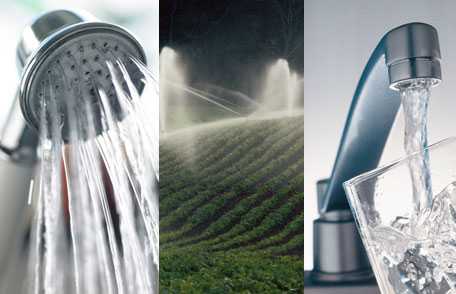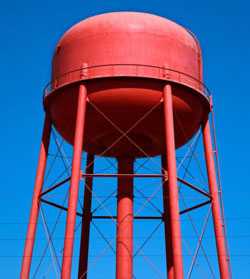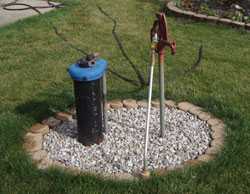Ground Water Awareness Week
 Much of the water we use comes from the ground. Learn more about ground water, the threats to its safety, and how to protect its sources during Ground Water Awareness Week.
Much of the water we use comes from the ground. Learn more about ground water, the threats to its safety, and how to protect its sources during Ground Water Awareness Week.
Clean water is one of the world’s most precious resources. People use water every day for many activities, such as drinking, bathing, recreation, agriculture, cooling, manufacturing, and medical uses. Although water plays an essential role in everyone’s life, many people don’t realize that much of their water comes from the ground.
National Ground Water Awareness Week, an annual observance sponsored by the National Ground Water Association (NGWA), is March 5–11, 2017. This observance highlights how important ground water is to people’s health and the environment.1

All ground water sources should be protected from contamination (germs and harmful chemicals).
Ground Water Contamination
Ground water is water that is located below the surface of the earth in spaces between rock and soil. Thirty percent of all freshwater is ground water.2 Ground water supplies water to wells and springs and is an important source of water for public water systems and private wells in the United States.3
Protecting the safety of ground water is an important priority for countries throughout the world, including the United States. Most of the time, ground water in the United States is safe to use. However, ground water sources can become contaminated with germs, such as bacteria, viruses, and parasites, as well as chemicals, like those used in fertilizers and pesticides, which can cause sickness and disease.
Naturally occurring germs and harmful chemicals from the environment, such as arsenic and radon, sometimes can be found in ground water. However, contamination is more often the result of human activities.4 These activities can include incorrect use of fertilizers and pesticides; poorly sited, constructed, or maintained septic systems; improper removal or storage of wastes; mining and construction; and chemical spills at work sites.4
Research has shown that most reported disease outbreaks from drinking water were caused by contamination of ground water systems, either because the ground water was untreated or because of problems with water treatment.5 The most common germs identified in ground water outbreaks include:
Other germs that cause outbreaks from ground water include parasites (Cryptosporidium), bacteria (Escherichia coli O157:H7), and viruses. Between 2009 and 2012, 28 outbreaks caused by contaminated drinking water from ground water systems were reported to CDC.6,7
The presence of germs and harmful chemicals in our drinking water can lead to health problems, including diarrhea, reproductive problems, and neurological disorders.6,8 Infants, young children, pregnant women, the elderly, and people whose immune systems are compromised because of HIV/AIDS, chemotherapy, or transplant medications may be more likely to get sick from certain germs and chemicals.
Concerns for ground water contaminants led the U.S. Environmental Protection Agency (EPA) and individual states to develop regulations such as the Ground Water Rule, which was published in 2006 to protect public water systems.

Water infrastructure requires regular maintenance.

Private well owners should have their water tested annually.
Where Does Your Water Come From?
105 million Americans get their tap water from a public water system that uses ground water
One-third of Americans get their drinking water from public water systems that use ground water. That’s more than 105 million people.9 The EPA regulates drinking water quality in public water systems. You can find out more about your local drinking water quality and possible contaminants by viewing your consumer confidence report (CCR), which most utility companies are required to provide to customers.10
34 million Americans get drinking water from private wells
An estimated 34 million Americans get their water from private ground water wells, which are not subject to EPA regulations.11 Private ground water wells can provide safe, clean water. However, contamination that can cause sickness also can occur in well water. If you have a well, you should take steps to protect it and have the water tested annually to make sure your water is safe from harmful germs and chemicals.12 State and local health departments provide information to help well users protect their drinking water.
References
- National Ground Water Association. National Ground Water Awareness Week.
- U.S. Geological Survey (USGS). Earth’s Water Distribution. Updated December 2016.
- U.S. Environmental Protection Agency. Information about Public Water Systems. Updated November 2016.
- U.S. Environmental Protection Agency. Getting Up to Speed: Groundwater Contamination [204 KB]. Updated in 2015.
- Craun GF, Brunkard JM, Yoder JS, Roberts VA, Carpenter J, Wade T, Calderon RL, Roberts JM, Beach MJ, Roy SL. Causes of outbreaks associated with drinking water in the United States from 1971 to 2006. Clin Microbiol Rev 2010;23:507-28.
- CDC. Surveillance for Waterborne Disease Outbreaks Associated with Drinking Water and Other Nonrecreational Water — United States, 2009–2010. MMWR Morb Mortal Wkly Rep. 2013;62(35):714-20.
- CDC. Surveillance for Waterborne Disease Outbreaks Associated with Drinking Water — United States, 2011–2012. MMWR Morb Mortal Wkly Rep. 2015:64(31);842-48.
- U.S. Environmental Protection Agency.Table of Regulated Drinking Water Contaminants. Updated October 2016.
- U.S. Environmental Protection Agency. Fiscal Year 2010 Drinking Water and Ground Water Statistics [115 KB]. Updated in 2011.
- U.S. Environmental Protection Agency. Consumer Confidence Report Rule and Rule History for Water Systems. Updated December 2012.
- National Groundwater Association. Groundwater Use in the United States of America [128 KB]. August 2016.
- U.S. Environmental Protection Agency. Key Steps to Protect Your Well. Updated June 2016.
More Information
More Information
- Public Water Systems – CDC
- Free online training for people with water wells
- Private ground water wells – CDC
- Safe Watch for Community Health (Safe WATCH) – CDC
- Well maintenance – CDC
- Wellowner.org
- Videos, posters, and fact sheets on keeping the water safe to drink in private wells, from health departments – CDC
- Page last reviewed: March 3, 2017
- Page last updated: March 3, 2017
- Content source:
- National Center for Emerging and Zoonotic Infectious Diseases, Division of Foodborne, Waterborne, and Environmental Diseases
- Page maintained by: Office of the Associate Director for Communication, Digital Media Branch, Division of Public Affairs




 ShareCompartir
ShareCompartir